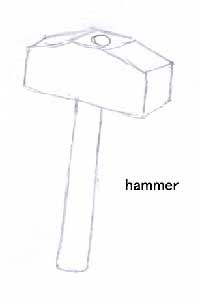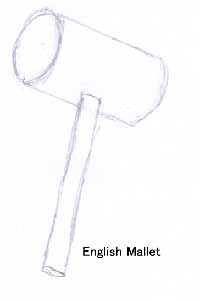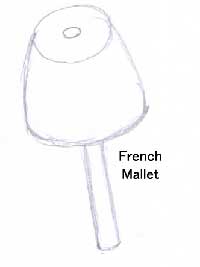Stone carving: Difference between revisions
No edit summary |
No edit summary |
||
| Line 7: | Line 7: | ||
The most basic tools required are a hammer and chisel. Hammers come in a veriety of shapes weights and sizes and are generally described in units of ounces. The masons hammer has a rectangular flat faced head and a relatively short shaft compared to a framing hammer used in common carpentry. For strong apllication of energy the face is used, in order to use the mass effectively to transfer smaller amounts of energy the side of the hammer head is used. By adjusting the degree of force the amount of material removed in a single stroke can be modified. The greater the force the larger the amount of material removed and the greater cthe chance the block will react poorly and split in unforeseen ways. Mallets are another variety of hammer that are a specialized group that have larger heads that are made out of wood (general a fruit wood like apple which has extremely strong and close grain) or synthetics. There are too basic styles of mallet, French and English. The French mallet consists of a round drum which the shaft passes through the center of the diameter of the drums altitude. The English mallet is the drum is perpendicular to the shaft. The French mallet is preferable to the English in that it allows finer adjustments in the transfer of energy and is more forgiving when not swung correctly at the chisel head. French mallets are most effective when the chisel is struck with the widest part of the drum which is closer to the shaft. <br>[[Image:mhammer.jpg]][[Image:Englishm.jpg]][[Image:frenchm.jpg]]<br> |
The most basic tools required are a hammer and chisel. Hammers come in a veriety of shapes weights and sizes and are generally described in units of ounces. The masons hammer has a rectangular flat faced head and a relatively short shaft compared to a framing hammer used in common carpentry. For strong apllication of energy the face is used, in order to use the mass effectively to transfer smaller amounts of energy the side of the hammer head is used. By adjusting the degree of force the amount of material removed in a single stroke can be modified. The greater the force the larger the amount of material removed and the greater cthe chance the block will react poorly and split in unforeseen ways. Mallets are another variety of hammer that are a specialized group that have larger heads that are made out of wood (general a fruit wood like apple which has extremely strong and close grain) or synthetics. There are too basic styles of mallet, French and English. The French mallet consists of a round drum which the shaft passes through the center of the diameter of the drums altitude. The English mallet is the drum is perpendicular to the shaft. The French mallet is preferable to the English in that it allows finer adjustments in the transfer of energy and is more forgiving when not swung correctly at the chisel head. French mallets are most effective when the chisel is struck with the widest part of the drum which is closer to the shaft. <br>[[Image:mhammer.jpg]][[Image:Englishm.jpg]][[Image:frenchm.jpg]]<br> |
||
The chisel is obtainable in a wide variety of sizes and shapes for various functions. The major classes of chisels are for use with hammers, and airguns, and mallets which must never be struck with a hammer. The two classes of chisel are differentiated by their ends one having a flat surface and the other having a bulb. |
The chisel is obtainable in a wide variety of sizes and shapes for various functions. The major classes of chisels are for use with hammers, and airguns, and mallets which must never be struck with a hammer. The two classes of chisel are differentiated by their ends one having a flat surface and the other having a bulb. The reason a chisel intended for a mallet must never be hit with a hammer is that the bulb that recieves the engergy will bloom or flatten out this will then damage the head of the mallet<br>[[Image:chiselm.jpg]]<br>[[Image:chisel.jpg]] |
||
Revision as of 08:30, 24 April 2005
Stone Carving The reduction of a block of stone to a finished state using a variety of tools is to be considered carving. Prodedures of carving processes can be used to create masonry for construction or for decorative purposes or both combined. Stone Carving has evolved slowly, many of the same techniques have been used for millenia. The recent trend to modernization of tools, the use of airguns, computer controlled cutters etc., cannot yet improve upon works finished by hand. Anyone able to swing a hammer and and hold a chisel at the same time can attempt to carve. The tools required to start are relatively inexpensive and few, and yet to obtain a complete array of tools to run a full size workshop would cost several hundreds of dollars.
The stone used is a wide in variety, from igneous to sedimentary, hard to exceptionally soft. The most common stones carved are granite, sandstone, marble, and limestone. Others such as basalt, soapstone, alabaster are also occasionally carved. With certain stone care must be taken not to breath the resulting dust, especially sandstone and granite which releases silicates that destroy lung tissue. Other stones may contain other dangerous minerals such as asbestos, for example Tigers Eye.
The choice of stone is predicated upon the necessity of durabilty, weatherability, color, availabilty, cost and ease of carving.
The most basic tools required are a hammer and chisel. Hammers come in a veriety of shapes weights and sizes and are generally described in units of ounces. The masons hammer has a rectangular flat faced head and a relatively short shaft compared to a framing hammer used in common carpentry. For strong apllication of energy the face is used, in order to use the mass effectively to transfer smaller amounts of energy the side of the hammer head is used. By adjusting the degree of force the amount of material removed in a single stroke can be modified. The greater the force the larger the amount of material removed and the greater cthe chance the block will react poorly and split in unforeseen ways. Mallets are another variety of hammer that are a specialized group that have larger heads that are made out of wood (general a fruit wood like apple which has extremely strong and close grain) or synthetics. There are too basic styles of mallet, French and English. The French mallet consists of a round drum which the shaft passes through the center of the diameter of the drums altitude. The English mallet is the drum is perpendicular to the shaft. The French mallet is preferable to the English in that it allows finer adjustments in the transfer of energy and is more forgiving when not swung correctly at the chisel head. French mallets are most effective when the chisel is struck with the widest part of the drum which is closer to the shaft. 


The chisel is obtainable in a wide variety of sizes and shapes for various functions. The major classes of chisels are for use with hammers, and airguns, and mallets which must never be struck with a hammer. The two classes of chisel are differentiated by their ends one having a flat surface and the other having a bulb. The reason a chisel intended for a mallet must never be hit with a hammer is that the bulb that recieves the engergy will bloom or flatten out this will then damage the head of the mallet

in medias res